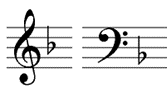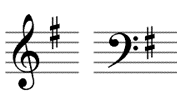Music which is written in a minor key will usually use a mixture of a key signature plus accidentals.
There are no special minor key signatures in music theory- we use the same ones as in the major keys, but we write accidentals in the music where they are needed.
Let’s look at A minor again, as an example. We’ve looked at two different types of minor scale:
- A minor harmonic: A – B – C – D – E – F – G# – A
- (Trinity only) A minor natural (or “Aeolian”): A – B – C – D – E – F – G – A
So, in a piece of music in the key of A minor, sometimes we might need a G# and sometimes a G natural!
For the key signature, we use the notes from the natural minor scale. For A minor, this means no sharps or flats, so it’s the same key signature as C major (i.e. nothing to see).
The key signature for a minor key is always the same as the key signature for the major key which is the 3rd degree of the minor scale.
Count up three notes from the tonic to find the key with the same key signature. For example, in A minor, the 3rd degree of the scale is C, so A minor and C major have the same key signatures.
In the Grade Two Music Theory exam (ABRSM and Trinity), you also need to know about D minor and E minor, so let’s work out the key signatures for these two:
D minor: D – E – F.
F is the 3rd degree of the scale of D minor, so the key signature for D minor is the same as for F major – one flat.

E minor: E – F# – G.
G is the 3rd degree of the scale of E minor, so the key signature for E minor is the same as for G major – one sharp.

We use the words “relative minor” and “relative major” to talk about this relationship. For example, C major is the relative major to A minor.